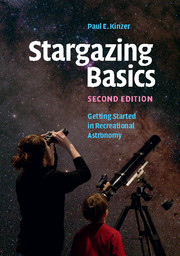Book contents
- Frontmatter
- Dedication
- Contents
- Acknowledgments
- Preface to the second edition
- Introduction: why another stargazing guide?
- Part I Stargazing techniques and equipment
- Part II What's up there?
- Part III A stargazing glossary
- Appendix 1 the Greek alphabet
- Appendix 2 the constellations
- Some simple star chart
- Index
- Plate section
Some simple star chart
from Part III - A stargazing glossary
Published online by Cambridge University Press: 05 August 2015
- Frontmatter
- Dedication
- Contents
- Acknowledgments
- Preface to the second edition
- Introduction: why another stargazing guide?
- Part I Stargazing techniques and equipment
- Part II What's up there?
- Part III A stargazing glossary
- Appendix 1 the Greek alphabet
- Appendix 2 the constellations
- Some simple star chart
- Index
- Plate section
Summary
Here are eight maps of the night sky; one for each of the seasons, for both the northern and southern hemispheres. They were created, in part, with the planetarium software program Sky Chart III, (available at www.southernstars.com/skychart/). Because of the scale used for this guide, the charts show little detail, but I have included them as a starting point. Under the starry sky, they should help you to find the brighter constellations; and the line marking the ecliptic might help you find planets. The lines used to show the constellation figures are those designed by H.A. Rey, for the book The Stars: A New Way to See Them (see page 27).
To use them outside, simply face in one of the directions marked around the edge of the chart that corresponds closely to the time and date at which you are using it. Then lift the book up, turning it so that the direction you are facing is at the bottom. You should now be able to match the chart with the sky. Start with a shape you are familiar with (the Big Dipper in the north and the Southern Cross in the south are visible at virtually any time of year), and use it and the chart to move on to new constellations.
I used the latitudes 45 degrees north and 30 degrees south because these seemed the best for the most people around the world. If you live north or south of these latitudes, the sky will not match the charts; but, unless you are quite distant, you should still get some use from them.
- Type
- Chapter
- Information
- Stargazing BasicsGetting Started in Recreational Astronomy, pp. 151 - 159Publisher: Cambridge University PressPrint publication year: 2015

